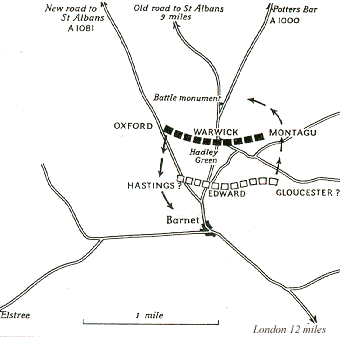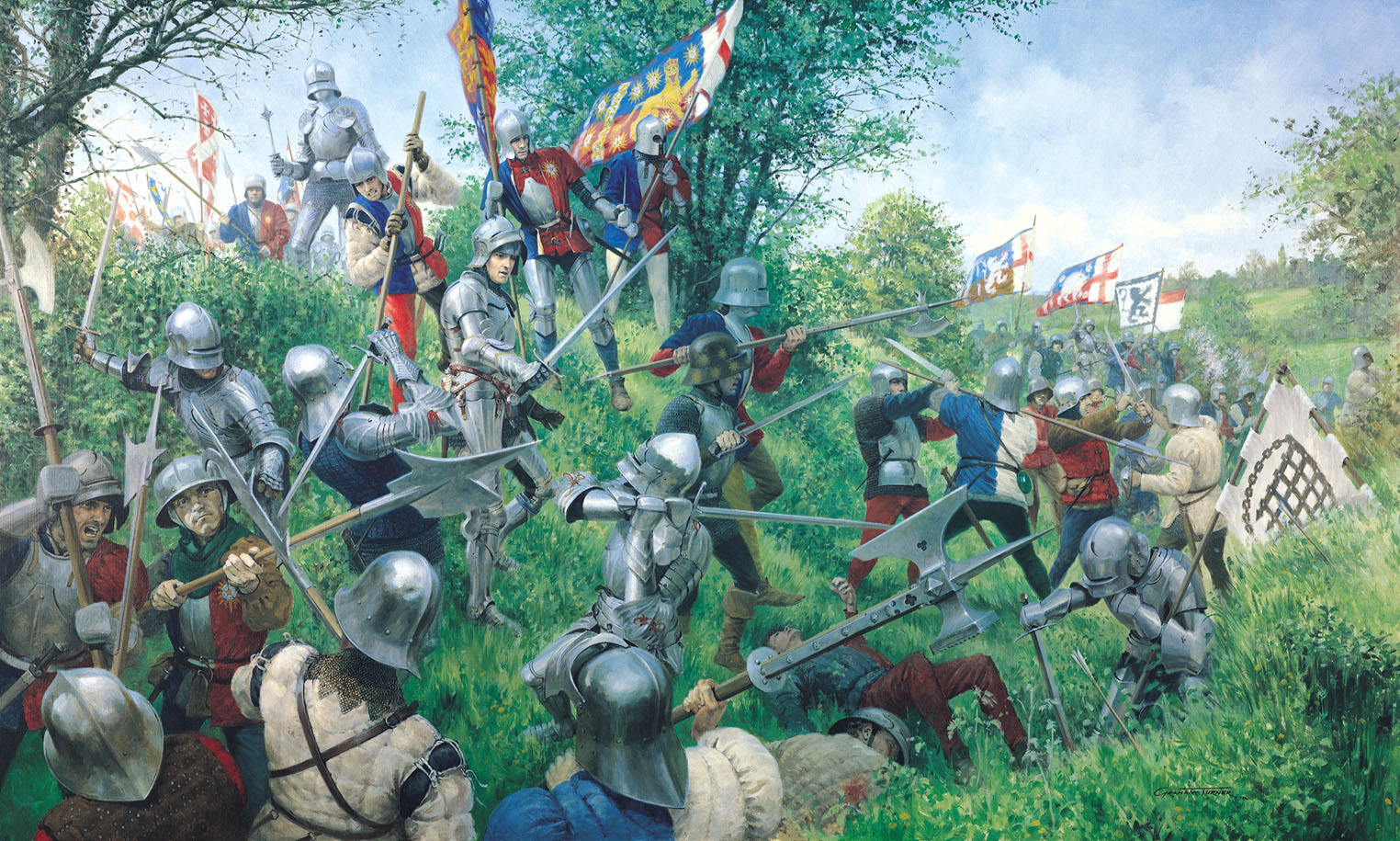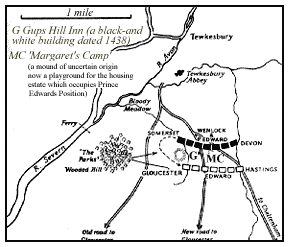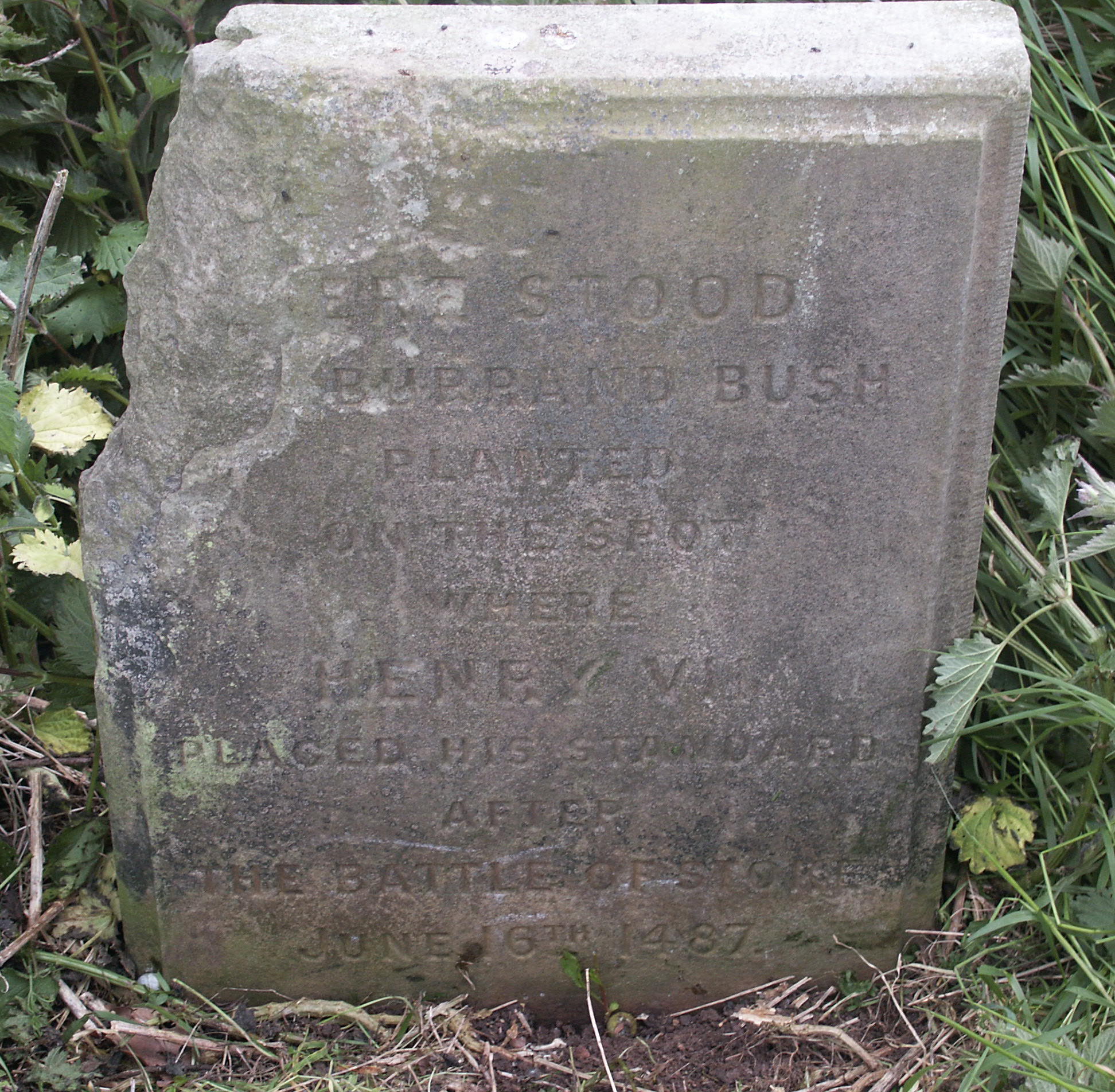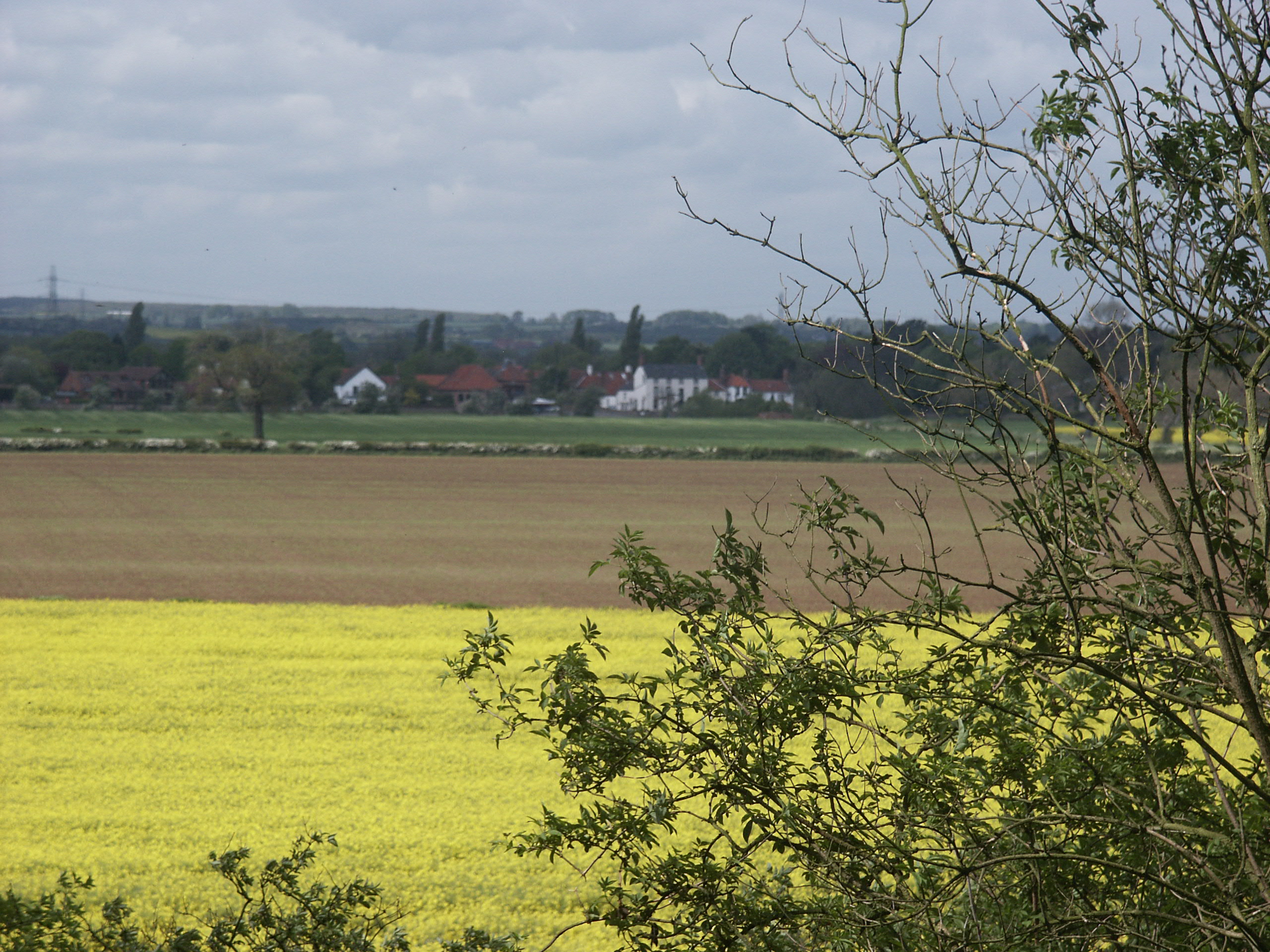The information on this page has been gathered primarly from the Richard
III Foundation, although some links to the pedigrees of some of the
participants have been added. Visitors are invited to consult their website
for updated information and information on their program.
The Wars of Roses
Principal Battles of The Wars of Roses
In Chronological Order
1455: 22 May - First Battle of
St. Albans 
1459: 23 September - Blore Heath
1460: 10 July - Northhampton
1460: 30 December - Wakefield 
1461: 2 February - Mortimer�s Cross.
1461: 17 February - Second Battle
of St. Albans 
1461: 29 March - Towton 
1464: 25 April - Hedgeley Moor
1464: 14 May - Hexham
1464: June - Bamburgh Castle
1469: 26 July - Edgecote
1470: 12 March - Empingham -'Losecoat Field'
1471: 14 April - Barnet
1471: 4 May - Tewkesbury
1485: 22 August - Bosworth Field 
1487: 16 June - Stoke Field  |
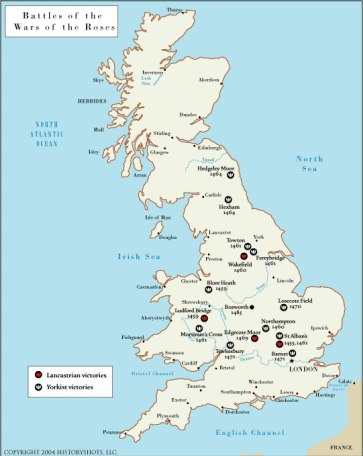
The War of Roses refers to a conflict fought in late Medieval England,
which was essentially a power struggle between noble factions who were
fighting for the right to the throne of England.
On one side was the House of Lancaster, who in King Henry VI held the
throne. However the King was a weak leader and prone to bouts of mental
illness, which meant that frequently his wife, Queen Margaret of Anjou,
reigned in his place.
The King was opposed by the House of York led by Richard Duke of York,
who felt that he had a stronger claim to the throne. He was also a wealthy
and powerful nobleman, which counted for a lot in the 15th century.
Relations between the two sides grew increasingly tense from 1450, and
erupted into violence and bloodshed at St Albans in 1455. An uneasy peace
held for 4 years after that, although both sides grew increasingly wary
of each other and continued to actively build up their armed forces.
|
|
First Battle
of St. Albans
May 22, 1455
The first battle of the "Wars of the Roses" was fought out between the
retinues of King Henry VI's supporters and those of the Duke of York and
his allies. The latter, along with his kinsmen the Earls of Warwick and
Salisbury, raised around 3.000 men and attacked Henry's army of 2,000 men
who had barricaded themselves inside the town of St Albans. After the Yorkist's
initial attacks had been repulsed, Warwick's men forced their way into
the town and the King's forces were overwhelmed in the street fighting
that ensued. The Duke of Somerset, the Earl of Northumberland, Lord Clifford,
plus about 50 other notable Lancastrians, were killed in the fighting.
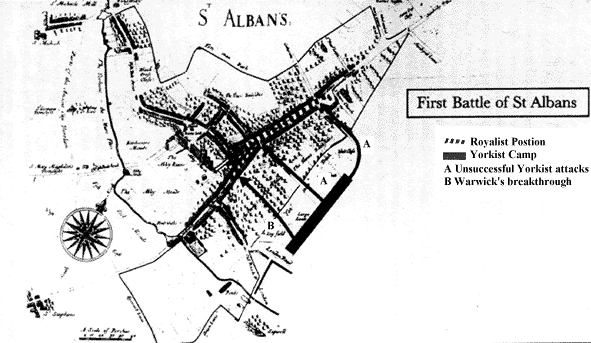
|
|
Major Participants of First Battle of St. Albans
|
| House
of York |
House
of Lancaster |
| James
Baskervillle of Eardisley, Herefordshire |
Ralph
Babthorpe of Babthorpe, Yorkshire (killed in battle) |
| Edward
Brooke of Holditch, Suffolk |
Edmund
Beaufort, Somerset (killed in battle) |
| William
Bourchier of Brampton, Devon |
Sir
Henry Beaufort, Earl of Dorset, wounded |
| Edward
Bouchier, Essex |
James
Butler, Wiltshire |
| Henry
Bouchier of Pleshey, Essex |
Thomas
Clifford of Skipton Craven, Yorkshire (killed in battle) |
| Christopher
Conyers of Sokebourne, Durham |
Richard
Cotton of Hampstall Ridware, Staffordshire (killed in battle) |
| John
de Clinton of Amington, Warwickshire |
Sir
Thomas Courtenay, Earl of Devon, captured |
| Walter
Devereux of Weobley, Herefordshire |
Bertine
Entwisell of Entwisell, Lancashire |
| Ralph
Fitzrandolph of Spennithorne, Yorkshire |
Robert
Harcourt of Stanton Harcourt, Oxford |
| Thomas
Lumley of Lumley, Durham |
Richard
Harrington of Westerley, Lancashire (killed in battle) |
| Richard
Hamerton of Hamerton, Yorkshire |
Richard
Harrowden of Harrowden, Northamptonshire (killed in battle) |
| Thomas
Harrington of Hornby, Lancashire |
Henry
Plantagenet, (Henry VI), captured |
| James
Metcalfe of Nappa, Yorkshire |
William
Neville, Lord Fauconberg, captured |
| John
Middleton of Belsay Castle, Northumberland |
Thomas
Packington of Hampton Lovett, Worcestershire |
| Christopher
Moresby of Moresby, Cumberland |
Thomas
Percy of Egremont Castle, Cumberland |
| Thomas
Mountford of Hackforth, Yorkshire |
Henry
Percy of Alnwick, Northumberland (killed in battle) |
| John
Mowbray of Framlingham, Suffolk |
John
Radcliffe of Smithills, Lancashire (killed in battle) |
| Richard
Neville of Middleham, Yorkshire (Earl of Westmoreland) |
Thomas
Roos of Rockingham, Northamptonshire |
| Richard
Neville of Middleham, Yorkshire (Earl of Warwick) |
Ralph
Shirley of Shirley, Sussex |
| William
Neville of Skelton, Yorkshire |
Henry
Stafford of Stafford, Staffordshire (killed in battle) |
| Robert
Ogle of Choppington, Northumberland |
Lord
Humphrey Stafford of Stafford, Staffordshire |
| William
Oldhall of Hunsdon, Herefordshire |
Edmund
Sutton of Dudley, Worcestershire |
| William
Parr of Carlisle |
John
Sutton of Dudley, Worcestershire |
| Thomas
Parr of Kendal, Westmoreland |
Thomas
Tresham of Rushton, Northamptonshire |
| John
Parr of Westminster, Westmoreland |
Thomas
Thorpe of Thorpe, Northumberland |
| James
Pickering of Ellerton, Yorkshire |
Edmund
Tudor, Earl of Richmond |
| Edward
Plantagenet, (Edward IV), Middlesex |
Jasper
Tudor of Hatfield, Anglesey |
| Richard,
Plantagenet of Fotheringhay, Northamptonshire (Duke of York) |
John
Wenlock of Wenlock, Shropshire |
| William
Pudsey of Selaby, Durham |
Philip
Wentworth of Nettlestead, Suffolk |
| Thomas
Rempston of Warren, Huntingdon |
Richard
West of Hempston-Cantilupe, Devon |
| Henry
Retford of Lincolnshire |
|
| John
Savile of Thornhill, Yorkshire |
|
| James
Strangeways of Whorlton, Yorkshire |
|
| Walter
Strickland of Sizergh, Westmoreland |
|
| Thomas
Vaughan of Hergest, Herefordshire |
|
| James
Wandesford of Kirklington, Yorkshire |
|
| Richard
Grey of Powis, Powis |
|
|
The Battle
of Blore Heath
September 23, 1459
The Battle of Blore Heath was the first major battle in the English
War of Roses and was fought on September 23, 1459, at Blore Heath, two
miles east of Market Drayton in Shropshire, England.
After four years of uneasy peace the King presided over a wasting realm.
No parliament had been summoned for three years, the country was sadly
divided and distressed.
In September 1459, a further conflict was looking more and more likely.
The Yorkist force based at Middleham Castle in Yorkshire (led by Richard
Neville, 5th Earl of Salisbury) needed to join with the main Yorkist army
at Ludlow Castle in Shropshire. As Salisbury marched south-west through
the Midlands the Queen ordered James Touchet, Lord Audley to raise a force
to intercept them.
The Yorkists were armed, armies were marching across all England. Lord
Audley had recently raised a Lancastrian army centered round Market Drayton,
and the Queen -through whom the King ruled- sent him orders to intercept
Lord Salisbury, who was marching from Yorkshire to join the Duke of York
at Ludlow. The two armies met head on two and a half miles east of Market
Drayton at a place called Blore Heath. Salisbury, with 3,000 troops, was
outnumbered by more than two to one, but could not avoid giving battle.
Audley took up a position just west of a little stream that crossed
the Market Drayton-Newcastle-under-Lyme road, and Salisbury�s men were
drawn up about 150 yards east of the present Audley Cross, which marks
the spot where Lord Audley fell. The Yorkist left rested upon the boggy
edge of a wood, but their right was in the air, and Salisbury made a laager
of his wagons to protect this flank. Whether Salisbury feigned retreat
in order to draw Audley on is not certain, but the Lancastrian commander
was definitely the one to attack. Two cavalry charges were repulsed, the
first with heavy loss to the Lancastrians, and then they mounted an infantry
attack up the hill to the Yorkist position. But this too failed; there
was no support from the cavalry, Lord Audley had already fallen and 500
Lancastrians chose this moment to desert to the enemy. Salisbury�s victory
was complete and in the pursuit, which continued for two miles, the slaughter
was very heavy. Possibly 2,000 Lancastrians perished in this battle, but
fewer than 200 Yorkists fell.
Audley chose the barren heathland of Blore Heath to set up an ambush.
On the morning of the 23 September 1459 (St Tecla's day), a force of some
6-12,000 men took up a defensive position behind a 'great hedge' on the
south-western edge of Blore Heath facing the direction of Newcastle-under-Lyme
to the north-east, the direction from which Salisbury was approaching.
Yorkist scouts spotted Lancastrian banners visible over the top of a
hedge and immediately warned Salisbury. As they emerged from the woodland,
the Yorkist force of some 3-6,000 men realized that a much larger enemy
force was awaiting their arrival. Salisbury immediately arranged his men
into battle order, just out of range of the Lancastrian archers. To secure
his right flank, he arranged the supply wagons in a defensive laager, a
circular formation to provide cover to the men on that flank. Fearing a
rout, Yorkist soldiers are reported to have kissed the ground beneath them,
supposing that this would be the ground on which they would meet their
deaths.
The two armies were separated by about 300 metres on the barren heathland.
A steep-sided, wide and fast-flowing brook flowed between them. The brook
made Audley's position seemingly inpenetrable.
Initially, both leaders sought to parley in a futile attempt to avoid
bloodshed. In keeping with many late medieval battles, the conflict opened
with an archery duel between the longbows of both armies. At Blore Heath,
this proved inconclusive because of the distance between the two sides.
Salisbury, aware that any attack across the brook would be suicidal,
employed a ruse to encourage the enemy to attack him. He withdrew some
of his middle-order just far enough that the Lancastrians believed them
to be retreating. The Lancastrians launched a cavalry charge. After they
had committed themselves, Salisbury ordered his men to turn back and catch
the Lancastrians as they attempted to cross the brook. It is possible that
the order for this Lancastrian charge was not given by Audley but it had
the effect of turning the balance in favour of Salisbury. The charge resulted
in heavy casualties for the Lancastrians.
The Lancastrians withdrew, and then made a second assault, possibly
attempting to rescue casualties. This second attack was more successful
with many Lancastrians crossing the brook. This led to a period of intense
fighting in which Audley himself was killed, possibly by Sir Roger Kynaston
of Stocks near Ellesmere.
The death of Audley meant that Lancastrian command devolved on to the
second-in-command John Sutton, 1st Baron Dudley, who ordered an attack
on foot with some 4,000 men. As this attack also failed, some 500 Lancastrians
joined the enemy and began attacking their own side. At this, any remaining
Lancastrian resistance collapsed and the Yorkists only had to advance to
complete the rout.
The rout continued through the night, with the Yorkists pursuing the
fleeing enemy for miles across the countryside.
York was concerned that Lancastrian reinforcements were in the vicinity
and was keen to press on towards Ludlow. He made his camp on a hillside
at Market Drayton, which later took his name. York employed a local friar
to remain on Blore Heath throughout the night and to periodically discharge
a cannon in order to deceive any proximal Lancastrians into believing that
the fight was continuing.
It is believed that at least 3,000 men died in the battle, with at least
2,000 of these from the Lancastrian side. Local legend says that Hempmill
Brook flowed with blood for 3 days after the battle.
Legend has it that Margaret of Anjou watched the battle from the spire
of the church in nearby Mucklestone, before fleeing when she realised Audley
was being defeated. It is said that she employed a blacksmith, William
Skelhorn, to reverse the shoes on her horse to disguise her escape. The
anvil from the smithy stands in the churchyard at Mucklestone to commemorate
this event.
A cross was erected on Blore Heath after the battle to mark the spot
where Audley was slain. It was replaced with a stone cross in 1765. Audley's
Cross stands on Blore Heath to this day. Audley is buried in Darley Abbey
in Derbyshire.
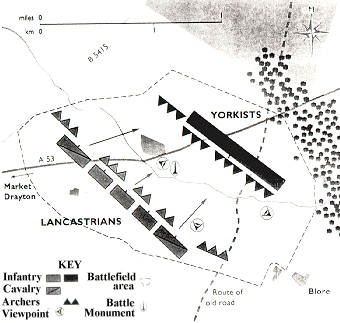
|
|
The
main Participants in the Battle of Blore Heath
|
| House
of Lancaster |
House
of York |
| Sir
Christopher Conyers of Sokebourne, Durham |
Sir
Henry Bromflete, Wymington, Bedford |
| Sir
John Conyers of Hornby, Yorkshire |
Sir
Robert del Booth of Wilmslow, Cheshire (killed in battle) |
| Sir
Walter Devereux of Weobley, Herefordshire (killed in battle) |
Sir
John Bourchier of West Horsley, Surrey |
| Sir
Richard Grey of Powis, Powis |
Sir
Hugh Calveley of the Lea, Cheshire (killed in battle) |
| Sir
Richard Hamerton of Hamerton, Yorkshire |
Sir
William Catesby (Sr.) of Ashby St. Legers, Northamptonshire |
| Sir
Thomas Harrington, Lancashire |
Sir
John Dawne of Cheshire |
| Sir
Roger Kynaston of Hordley, Shropshire |
Sir
Jerkin Done of Wickington, Cheshire (killed in battle) |
| Sir
Thomas Lumley of Lumley, Durham |
Sir
Robert Downes of Shrigley, (killed in battle) |
| Thomas
Meering of Tong |
Sir
Thomas Dutton of Dutton, Cheshire (killed in battle) |
| Sir
James Metcalfe of Nappa, Yorkshire |
Sir
John Dwnn of Cheshire, killed in battle |
| Sir
John Middleton of Belsay Castle, Northumberland |
Sir
John Egerton of Egerton, Cheshire (killed in battle) |
| Sir
Thomas Mountford of Hackforth, Yorkshire |
Sir
Nicholas of Eyton of Eyton, Shropshire |
| Sir
Richard Neville (Earl of Salisbury) of Middleham, Yorkshire (fled to Calais) |
Sir
Richard Fitton of Gawsforth, Cheshire |
| Sir
Richard Neville (Earl of Warwick) of Middleham, Yorkshire (fled to Calais) |
Thomas
Fitton, fate unknown |
| Sir
Thomas Neville of Thornton Bridge, Durham |
Sir
John Haigh, killed in battle |
| Sir
Robert Ogle of Ogle, Northumberland |
Sir
Edmund Hampden of Hampden, Buckinghamshire |
| Sir
Thomas Parr of Kendal, Westmoreland |
Sir
Thomas Hesketh of Rufford, Lancashire |
| Richard
Plantagenet, Duke of York, fled to Ireland |
Sir
Henry Holland of Darlington, Devon |
| Sir
William Pudsey of Selaby, Durham |
Sir
John Legh of Booths, Cheshire (killed in battle) |
| Sir
James Strangeways of Whorlton, Yorkshire |
Sir
Philip Maunsell of Scrurlage, Glamorgan |
| Sir
Walter Strickland of Sizergh, Westmoreland |
Sir
Richard Molyneux of Sefton, Lancashire (killed in battle) |
| Sir
John Wandesford of Kirklington, Yorkshire |
Sir
John Neville of Raby, Durham |
| Sir
John Wenlock of Wenlock, Shropshire |
Sir
Ralph Shirley of Shirley, Sussex |
| Sir
Walter Wrottesley of Wrottesley, Shropshire |
Sir
John Skidmore of Mochas, Herefordshire |
| |
Sir
John Stanley of Pipe, Staffordshire |
| |
Sir
Edmund Sutton of Dudley, Westmoreland |
| |
Sir
John Sutton of Dudley, Westmoreland |
| |
Sir
William Troutbeck of Dunham-on-the-Hill, killed in battle |
| |
James
Touchet (Lord Audley) of Markeaton, Derbyshire (killed in battle) |
| |
Sir
Hugh Venables of Kinderton (killed in battle) |
|
|
Interim
Immediately after Blore Heath the Yorkists were dispersed near Ludlow without
a battle, owing to the treachery of a large part of their army. The Yorkist
cause seemed finished after the previous disaster at Ludford Bridge.
York himself retired to Ireland, Salisbury and Warwick to Calais.Some
of the Yorkist commanders, Warwick, Salisbury and York's son Edward, Earl
of March reached Calais on 2nd November 1459, where Warwick found his uncle
Lord Fauconberg. Meanwhile York and Edmund, Earl of Rutland retired to
the relative safety of Ireland.
On the English mainland, the Lancastrians were quick to exploit the
Yorkist flight; the Earl of Wiltshire was appointed Lieutenant of Ireland
and Henry Beaufort, 3rd Duke of Somerset became Captain of Calais. Neither
however succeeded in occupying their new posts as the Irish refused to
dislodge York and the gates of Calais remained firmly closed to their new
'Captain'.
The Lancastrians gave Somerset an army to storm Calais, but first they
had to cross the Channel, so the construction of a fleet was started at
Sandwich in Kent. No sooner had the ships been finished than Warwick made
a raid on Sandwich and stole them. In May, Warwick crossed the channel
again and destroyed the new fleet under construction there. Warwick left
his uncle in Sandwich with a small force of Yorkists to act as a bridgehead
for his planned invasion of England.
The Queen summoned a parliament and Henry gave his assent to a bill
of attainder against all the principal Yorkist leaders. At the end of June
the Calais exiles made a landing in Kent, seized Sandwich and gathering
support entered London on 2 July. Here they were joined by almost all the
Yorkist peers and their retainers.
BATTLE OF NORTHAMPTON
July 10, 1460
On 26 June Warwick, Salisbury and Edward landed at Sandwich with 2,000
men at arms. The King and Queen were at Coventry with their small army.
Warwick entered London on 2nd July with an army of supporters numbering
between 20,000 and 30,000, and leaving a part of it to blockade the Tower,
held by Lancastrians, the remainder under Lord Warwick set out to meet
the King. The court had been in Coventy, but on learning of the Yorkist
advance the King moved to Northampton, and here on 10 July, entrenched
in a meadow just south of the town, Warwick found the Lancastrian army
under the Duke of Buckingham.
The Duke had fewer men than Warwick, but his position was a strong one
and his earthworks were lined with artillery. The first attack, on a three
section front, was repulsed; it seemed that the position was too formidable
a one for any frontal assault to succeed.
While approaching, Warwick sent a delegate to negotiate with the King
on his behalf. The Lancastrian commander, the Duke of Buckingham, however,
replied "The Earl of Warwick shall not come to the King's presence and
if he comes he shall die." During Warwick's advance to Northampton he was
twice more denied access to the King's person. Once in position, he sent
a message that read "At 2 o'clock I will speak with the King or I will
die."
At two o'clock the Yorkists advanced.
The men were in column, but the hard rain blowing in their faces somewhat
hindered them. As they closed with the Lancastrians, Warwick was met by
a fierce barrage of arrows; luckily for them, though, the rain had rendered
the Lancastrian collection of cannon quite useless.
When Warwick reached the Lancastrian right flank, commanded by Lord
Grey of Ruthin, treachery ensued. Grey had his men lay down their weapons
and simply allow the Yorkists to have easy access into the camp beyond.
This proved a fatal blow to the loyal Lancastrians: after this, the
battle lasted a mere thirty minutes. The defenders, unable to manoeuvre
inside the fortifications, fled the field as their line was rolled up by
attacking Yorkists.
The Duke of Buckingham, the Earl of Shrewsbury and Lords Egremont and
Beaumont all died trying to save Henry from the Yorkists closing on his
tent.
Three hundred Lancastrians were slain in the battle, the King was captured
and once more became a puppet in the hands of the Yorkists.
The casualties were not high, but as at St. Albans many of the Lancastrian
leaders, including Buckingham, Shrewbury and Egremont, were killed.
The King was captured and once more led back to London.
|

|
|
Major Participants of Battle of Northampton
|
| House
of York |
House
of Lancaster |
| John
Lord Clinton |
Sir
John Beaumont, Viscount Beaumont, killed in battle |
| Henry
Essex, Viscount Bourchier |
Jean
de la Foix, went over to Yorkists |
| William
Fiennes, Lord Say |
Edmund
Lord Grey of Ruthin, betrayed Lancastrian troops at battle |
| Henry
Mountford |
Henry
VI, King of England, captured |
| Sir
John Mowbray, Duke of Norfolk |
Lord
Hungerford, taken prisoner |
| Edward
Neville, Lord Abergavenny |
Earl
of Kendal, went over to Yorkists |
| Richard
Neville, Earl of Warwick |
John
Lord Lovel, taken prisoner |
| William
Neville, Lord Fauconberg |
Sir
William Lucy, killed in battle |
| Edward
Plantagenet, Earl of March |
Thomas
Percy, Lord Egremont, killed in battle |
| John
Lord Scrope of Bolton |
Humphrey
Stafford, Duke of Buckingham, killed in battle |
| Sir
John Stafford |
Sir
John Talbot, Earl of Shrewsbury, killed in battle |
| John
Touchet, Lord Audley |
Lord
de la Warre, went over to Yorlists |
|
|
The Battle
of Wakefield
December 30, 1460
Following the capture of Henry VI, Queen Margaret raised an army in
Yorkshire numbering some 15,000 men. The Duke of York and the Earl of Salisbury,
with an army of about 6,000 men, marched out of London in early December
and headed north. At Worksop they brushed aside a Lancastrian advance guard
commanded by the captain Andrew Trollope and arrived at Sandal castle in
Yorkshire. Unbeknown to York, the Lancastrians had concentrated
their forces at nearby Pontefract castle.
On 29th December a Yorkist foraging party blundered into the main body
of the Lancastrian army and was pursued back to Wakefield. The following
morning a force of about 6,000 men commanded by the Duke of Somerset and
Lord Clifford deployed for battle in full view of the Yorkist army in and
around Sandal castle. On seeing this, the Duke of York and the Earl of
Salisbury marched their army down from the castle onto level ground near
the River Calder. They did not realise that the Lancastrians had laid a
trap. As soon as York and Somerset became embroiled in a melee, two large
forces of the Lancastrian army, commanded by the Earl of Wiltshire and
Lord Roos, emerged from nearby woods surrounding the Yorkist army. Around
3,000 Yorkists were killed including the Duke of York. His son the Earl
of Rutland was killed escaping from the battlefield and the Earl of Salisbury
was captured that evening and executed the next day
|
| Yorkists
Sir Robert Apsall,
killed after battle
Edward Bourchier,
killed in battle
Sir David Hall, executed
Sir Thomas Harrngton,
executed
Sir Hugh Mortimer,
executed
Sir John Mortimer,
executed
Lord John Neville,
survived
Richard Neville,
Earl of Salisbury, killed in battle
Sir Thomas Neville,
killed in battle
Sir Thomas Parr,
executed
Sir James Pickering,
killed in battle
Edmund Plantagenet,
Earl of Rutland, killed after battle
Richard Plantagenet,
Duke of York, killed after battle
Sir Henry Retford,
killed in battle |
Lancastrians
Henry Beaufort, Duke
of Somerset
James Butler, Earl
of Wiltshire
John Lord Clifford
Thomas Courtenay,
Earl of Devon
Henry Lord Fitzhugh
Ralph Lord Greystoke
Henry Holland, Duke
of Exeter
George Neville, Lord
Latimer
Sir Henry Percy,
Earl of Northumberland
Thomas Lord Roos
Andrew Trollope |
|
Mortimer�s Cross
February 2, 1461
Queen Margaret was not present at Wakefield, but accompanied
the Lancastrian army on its destructive march south to St. Albans. Warwick
arrived in London at the beginning of February. On learning of York�s death
he appears to have made no effort to get in touch with the Earl of March
who was then on the Welsh Marsh. But Edward, although only nineteen years
old, had proven himself a capable soldier after defeating a Lancastrian
force at the Battle of Mortimer's Cross.
Edward, Earl of March was at Shrewsbury with an army of
about 10,000 men, raised in Wales and the Marches, when he received news
of the death of his father and brother at Wakefield. He was also told that
another Lancastrian army of about 8,000 men was marching out of South Wales
behind him commanded by the Earl of Pembroke, the Earl of Wiltshire and
Owen Tudor. Edward quickly headed south and deployed his army in three
battles straddling the road from Hereford at Mortimer's Cross. The Lancastrians
advanced from the south in three battles. The left under Wiltshire contained
a large number of lightly armed Irish, Breton and French mercenaries and
in the ensuing melee these troops were quickly routed. The Lancastrian
centre and right wing was then outflanked and crushed on the banks of the
River Lugg. Some 4,000 Lancastrians were killed, although Pembroke and
Wiltshire escaped.
On the morning of the battle, through an unusual atmospheric
condition, three suns were said to be visible. Edward took this as a propitious
omen and after his victory added the sun to his banner.
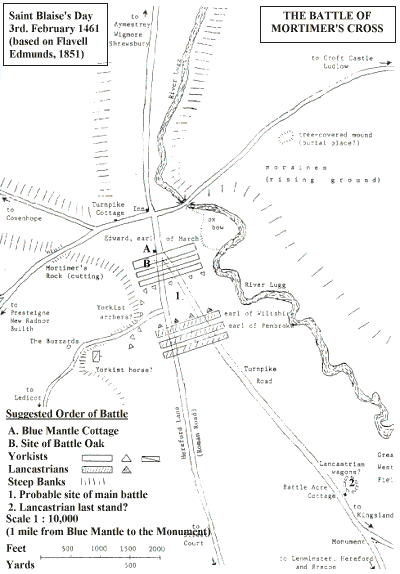
|
|
Major Participants of Battle of Mortimer's Cross
|
| House
of York |
House
of Lancaster |
| James
Baskerville |
James
Butler, Earl of Wiltshire, escaped |
| Sir
Richard Croft |
Hopkin
Davy of Carmarthen |
| Sir
Walter Devereaux |
Thomas
Fitzharry |
| John
Dwnn |
Owen
ap Griffith, escaped |
| Lord
FitzWater |
Thomas
ap Griffith, escaped |
| Lord
Grey of Wilton |
Rheinallt
Gwynnedd of Harlech |
| Henry
ap Griffith |
David
Lloyd, executed |
| Richard
Hakluyt |
Philip
Mansel, escaped |
| Mr.
Harper of Wellington |
Griffth
ap Nicholas, killed in battle |
| Sir
William Hastings |
Sir
Thomas Perot of Haverfordwest, escaped |
| Richard
Herbert |
Lewis
Powys of Powysland |
| Sir
William Herbert of Raglan |
Morgan
ap Rhydderch, executed |
| Sir
William Knylle |
Hopkin
ap Rhys of Gower, escaped |
| John
Lingen |
Lewis
ap Rhys of Carmarthen |
| Sir
John Lynell |
Sir
Harry Skydmore |
| John
Milewater |
James
Skydmore |
| Thomas
Monington |
Sir
John Skydmore, escaped |
| Walter
Mytton |
Sir
William Skydmore |
| Edward
Plantagenet, Earl of March |
Sir
John Throckmorton, executed |
| Sir
Humphrey Stafford |
Jasper
Tudor, Earl of Pembroke, escaped |
| John
Touchet, Lord Audley |
Owen
Tudor, executed |
| William
Thomas |
|
| Philip
Vaughan |
|
| Sir
Roger Vaughan |
|
| Thomas
Vaughan |
|
| Sir
John Wenlock |
|
|
Second Battle
of St. Albans
February 17, 1461
Following the defeat of the Yorkist army at Wakefield, a large Lancastrian
army of about 12,000 men pillaged and plundered its way south towards London.
At St Albans the Earl of Warwick and about 9.000 Yorkists encamped in and
about the north of the town on Barnard's Heath and Nomansland Common. Here
they constructed a number of defences including caltraps, spiked nets and
pavises and awaited the arrival of the Lancastrian army. The attack did
not come in the direction Warwick had anticipated: a large Lancastrian
vanguard entered St Albans from the direction of Dunstable and chased the
Yorkist rearguard out of the town. The main Yorkist army was then attacked
from the flank and rear. Even so, most of the Yorkist army withdrew in
good order amid the confusion. Warwick then marched west towards the approaching
Yorkist army commanded by Edward, Earl of March. This left London to defend
itself. When the Lancastrian army arrived outside the city walls the Londoners
refused to open the gates. Without sufficient artillery the Lancastrians
were forced to withdraw north to Yorkshire again. |
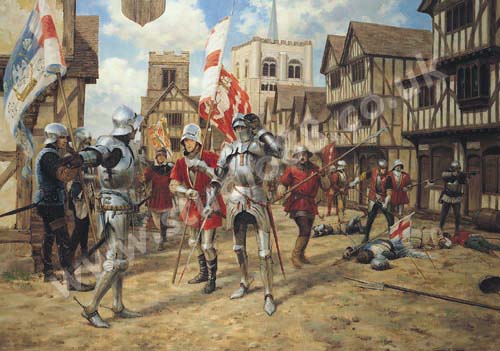
|
|
Major Participants of 2nd Battle of St. Albans
|
| House
of York |
House
of Lancaster |
| William
Lord Bonville, executed |
Henry
Beaufort, Duke of Somerset |
| Edward
Lord Bourchier |
John
Lord Clifford |
| John
Bourchier, Lord Berners, taken prisoner |
Thomas
Courtenay, Earl of Devon |
| Lord
Charlton, taken prisoner |
Henry
Lord Grey of Codnor |
| Sir
William Fitzalan, Earl of Arundel |
Sir
John Grey of Groby, killed in battle |
| William
Gregory |
Ralph
Lord Greystoke |
| Henry
VI, captured by Lancastrians |
Henry
Holland, Duke of Exeter |
| Sir
Thomas Kyriel, executed |
Henry
Percy, Earl of Northumberland |
| Sir
Henry Lovelace, went over to Lancastrians |
Robert
Poynings, killed in battle |
| John
Neville, Lord Montague, taken prisoner |
Henry
Lord Roos |
| Sir
John Mowbray, Duke of Norfolk |
Sir
William Tailboys, knighted |
| Richard
Neville, Earl of Warwick |
John
Talbot, Earl of Shrewsbury |
| William
Neville, Lord Fauconberg |
Sir
Andrew Trollope, knighted |
| John
de la Pole, Duke of Suffolk |
Richard
Willoughby, Lord Welles |
| Sir
John Wenlock |
|
|
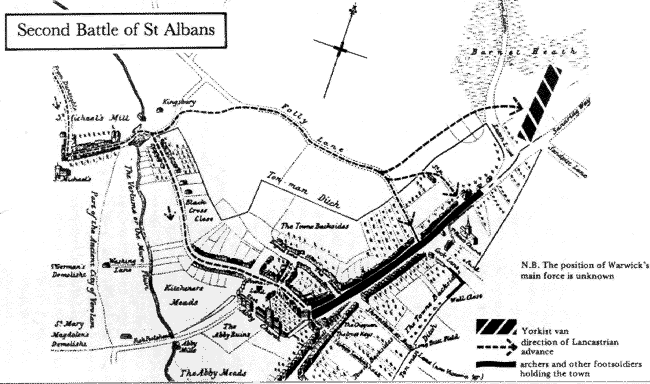
|
Battle
of Towton
March 29, 1461
After St. Albans,
Henry was reunited with his queen, but he refused too let his army advance
on London and instead the Lancastrians headed north again, plundering as
they went. Meanwhile, Warwick acted swiftly and had Edward proclaimed
king in London. Edward fully realized that there could not be two kings
in England, and on about 12 March he set out for the north. Lord Fauconberg
had marched in advance and Warwick had been dispatched to raise troops
in the Midlands. Somewhere north of the Trent Edward assembled his large
army of about 40,000 soldiers.A slight Yorkist
reverse was suffered at Ferrybridge, where Lord Fitzwalter�s troops were
surprised and their commander killed in an attack led by Lord Clifford;
but Clifford�s forces was soon caught and Clifford himself killed. The
Yorkists then proceeded to the higher ground, where the Lancastrians were
drawn up between the villages of Towton and Saxton.The
battle that was fought on this windswept plateau lasted for nearly the
whole day. Rather more than 80,000 men took part and this time the snowstorm
that set in favored the Yorkists. The advantage seemed to go first to one
side then to the other in this fiercely contested battle. About midday
the Duke of Norfolk�s troops arrived on the field and took position on
the Yorkist right flank. With his numbers thus increased, Edward was at
last able to turn the Lancastrian left and gradually, they began to fall
back, closely pressed by the Yorkists.Eventually
discipline snapped and in the mad rush to cross the Cock Beck and gain
the London road thousands of Lancastrians perished. The exact numbers of
those who died on the field of battle, or in the marshy fields of the beck,
are not known; but there has been no greater slaughter in any battle fought
on British soil. |
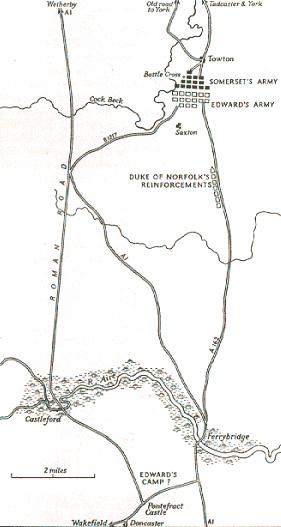
|
|
Major Participants of Battle of Towton
|
| House
of York |
House
of Lancaster |
| Edward
IV, Earl of March, later King of England, crowned 28 June, 1461 |
William
Ackworth, Esq, killed in battle and later attainted |
| Sir
John Asherton |
John
Aldeley,Esq |
| Sir
John Astley |
William
Antron,Esq |
| James
Baskerville, Esq |
John
Audley, killed in battle and later attainted |
| Thomas
Baskerville, Esq |
Sir
Thomas Babthorpe |
| Sir
Richard Beauchamp |
Henry
Beaufort, 3rd Duke of Somerset, attainted |
| Sir
Humphrey Blount |
Henry
Beaumont, Gent., killed in battle |
| Sir
Walter Blount, knighted |
John
Beaumont, Gent., killed in battle and later attainted |
| Humphrey
Bourchier, rewarded after battle |
Sir
Henry Bellingham, attainted |
| John
Bourchier, captured by Lancastrians and later freed |
Robert
Bellingham, Esq, killed in battle and later attainted |
| William
Viscount Bourchier, created Earl of Essex by Edward IV |
Sir
William Bertram |
| William
Brandon, Esq |
Sir
John Bigod, Lord Mauley, killed in battle |
| Edward
Brooke, Lord Cobham, rewarded after battle |
Sir
Henry Bokingham |
| Sir
Thomas Burgh |
Robert
Bolling, Gent.,killed in battle and later attainted |
| Sir
Nicholas Byron |
Edward
Brampton, killed in battle and later attainted |
| Sir
Robert Chamberlain |
Thomas
Brampton, Esq, killed in battle |
| Thomas
Claymond, attainted |
Thomas
Burnby |
| Sir
John Clay |
Sir
John Burton |
| Sir
Robert Clifton |
James
Butler, Earl of Wiltshire, executed after battle and later attainted |
| John
Lord Clinton, rewarded after battle |
Sir
John Butler, attainted |
| Sir
Christopher Conyers |
Sir
Thomas Butler, attainted |
| Sir
John Conyers |
Sir
Richard Carey |
| Sir
Roger Corbie, rewarded after battle |
Thomas
Carr, Yeoman, killed in battle and later attainted |
| Sir
Philip Courtenay |
Sir
William Catesby |
| Sir
Richard Croft the Younger, rewarded after battle |
John
Chapman, Yeoman, killed in battle and later attainted |
| Sir
Richard Croft the Elder, rewarded after battle |
Ralph
Chernok, Gent., killed in battle and later attainted |
| Sir
Gilbert Debenham |
Thomas
Claymond, Esq |
| Thomas
Denyes, Esq |
John
Baron Clifford, killed in battle |
| Sir
Walter Devereaux, knighted |
Sir
Roger Clifford |
| Sir
John Dinham, rewarded after battle |
Sir
Gervase Clifton |
| Sir
John Dunne, rewarded after battle |
Richard
Cokerell, Merchant, killed in battle and later attainted |
| Sir
Guy Fairfax |
Sir
John Courtenay, attainted |
| William
Fiennes, Lord Saye and Sele, rewarded after battle |
Thomas
Courtenay, Earl of Devon, executed after battle |
| Thomas
Fitzalan, Lord Maltravers, rewarded after battle |
Sir
John Crackenthorpe, killed in battle |
| Sir
John Fogge, rewarded after battle |
Sir
Thomas Crackenthorpe, killed in battle |
| Sir
Geoffrey Gate |
Thomas
Crawford, Esq, killed in battle and later attainted |
| Sir
Robert Green |
Sir
Henry Dacre |
| Edmund
Lord Grey of Ruthin, rewarded after battle |
Sir
Humphrey Dacre, attainted |
| Reginald
Lord Grey of Wilton, rewarded after battle |
Randolph
Lord Dacre of Gilsland, killed in battle and later attainted |
| Gruffyd
ap Henry, Esq |
Thomas
Daniel, Esq, killed in battle and later attainted |
| Richard
Hakluyt, Esq |
John
Dawson, Yeoman, killed in battle and later attainted |
| Sir
John Harcourt, Esq |
Sir
John Delves |
| Sir
Robert Harcourt, rewarded after battle |
Everard
Digby, Esq, killed in battle and later attainted |
| John
Harper, Esq |
John
Doubigging, Esq, killed in battle and later attainted |
| Sir
James Harrington |
Sir
John Dunn |
| Sir
Robert Harrington |
Sir
Thomas Elderton |
| Ralph
Hastings, Esq |
Edward
Ellesmere, killed in battle and later attainted |
| Sir
Richard Hastings |
Sir
Ralph Eure, killed in battle |
| Sir
William Hastings, knighted |
John
Everyingham, Esq, killed in battle and later attainted |
| Sir
William Herbert, knighted |
Richard
Everyingham, killed in battle and later attainted |
| Ralph
Hopton, Esq |
Sir
Thomas Everyingham, attainted |
| Robert
Horne, Esq, killed in battle |
Sir
William Fielding |
| Sir
John Howard, rewarded after battle |
Sir
John Fortescue, attainted |
| Sir
Richard Jenney, killed in battle |
Richard
Fulmady, Yeoman, killed in battle and later attainted |
| Sir
Henry Lewys |
Sir
Baldwin Fulford |
| Sir
George Lumley |
Sir
Thomas Fulford |
| Sir
Thomas Lumley |
Sir
Thomas Fyndern, attainted |
| Sir
John Markham |
Richard
Gaitford, Gent., attainted |
| Sir
Robert Markham |
Sir
William Gascoigne |
| Geoffrey
Middleton, Esq |
Sir
Ralph Grey |
| John
Milewater the Younger |
Sir
Thomas Grey, attainted |
| John
Milewater the Elder |
William
Grimsby, Esq, killed in battle and later attainted |
| Sir
Thomas Montgomery, rewarded after battle |
Sir
Edward Hamden, attainted |
| Thomas
Mornington |
Sir
Simon Hammes, attainted |
| Sir
Simon Mountford |
Sir
Richard Hammis, killed in battle |
| John
Mowbray, 3rd Duke of Norfolk, officiated as Earl Marshall at Edward IV�s
coronation |
Sir
Edmund Hampden |
| Walter
Myton |
Sir
William Harhill, killed in battle |
| Edward
Neville, Lord Abergavenny, rewarded after battle |
Lord
Harry, killed in battle |
| Richard
Neville, Earl of Warwick, wounded, later helped solidify Yorkist position
in the North |
Sir
Nicholas Harvey, attainted |
| William
Neville, Lord Fauconberg, created Earl of Kent |
Robert
Hatecale, Yeoman, killed in battle and later attainted |
| Sir
William Norrys |
Sir
William Havill, killed in battle |
| Sir
Robert Ogle, knighted |
John
Hawt |
| Robert
Palmer, Esq |
John
Haydon, Esq |
| Sir
Thomas Parr |
Sir
John Heron, killed in battle |
| Sir
John Paston |
Sir
Thomas Hervey |
| Sir
William Petche |
Sir
John Heyton, killed in battle |
| Sir
Henry Pierrepont |
Laurence
Hill, Yeoman, killed in battle and later attainted |
| Sir
John Pilkington |
Sir
William Hill, killed in battle |
| John
de la Pole, 2nd Duke of Suffolk |
Sir
Robert Hillyard, killed in battle |
| James
Radcliffe, Esq |
Sir
Alexander Hody |
| John
Radcliffe, Lord Fitzwalter, killed in battle |
Henry
Holland, Duke of Exeter, attainted |
| Sir
Laurence Rainsford, rewarded in battle |
Sir
William Holland, attainted |
| Sir
William Rainsford |
Robert
Lord Hungerford, attainted |
| Sir
Henry Ratcliffe |
Sir
Walter Hungerford, attainted |
| Sir
John Say, rewarded after battle |
William
Joseph, Esq, killed in battle and later attainted |
| Sir
John Scott, rewarded after battle |
John
Joskin, Esq, killed in battle and later attainted |
| John
Lord Scrope of Bolton, wounded but survived |
Richard
Kirkby, Gent., killed in battle and later attainted |
| Nicholas
Sharpe, Esq |
Sir
Nicholas Latimer, attainted |
| Henry
Sotehill |
John
Lenche, Esq, attainted |
| Fulk
Staffork, Esq |
Sir
Henry Lewes, attainted |
| Sir
Henry Stafford |
Richard
Lister the Younger, killed in battle and later attainted |
| Sir
Humphrey Stafford, knighted |
Thomas
Litley, Grocer, killed in battle and later attainted |
| Sir
John Stafford, killed in battle |
Sir
James Luttrell |
| Thomas
Lord Stanley |
John
Maidenwell, killed in battle and later attainted |
| Sir
William Stanley |
Ralph
Makerell, killed in battle and later attainted |
| John
Lord Stourton, rewarded in battle |
Thomas
Manning, killed in battle and later attainted |
| Thomas
Sturgeon, Esq |
Sir
John Marney |
| William
Sturgeon, Esq |
Sir
John Maulever |
| Sir
James Strangeways, rewarded after battle |
Sir
Thomas Metham |
| Sir
Richard Strangeways |
Sir
William Mille, attainted |
| Sir
Thomas Strickland |
John
Mirfin, Esq, attainted |
| Sir
William Stoner |
Sir
Thomas Molyneaux |
| John
Sutton, Lord Dudley, rewarded after battle |
Sir
John Montgomery, executed |
| William
Tendering, Esq |
John
Morton, killed in battle and later attainted |
| Sir
Roger Thornton of Nether Whitton, Northumberland |
Sir
Edmund Moundford, attainted |
| Sir
Thomas Thorpe |
John
Myrvyn |
| Sir
Lancelot Threlkeld of Threlkeld of Cumberland |
Sir
Henry Narbohew, killed in battle |
| Sir
Roger Tocotes of Bromham, Wilts, rewarded after battle |
John
Naylor, killed in battle and later attainted |
| John
Touchet, Lord Audley, rewarded after battle |
Sir
Charles Neville |
| Sir
Thomas Tudenham, of Oxborough, Norfolk |
Sir
Humphrey Neville |
| Sir
William Tyrell |
John
Lord Neville, killed in battle and later attainted |
| Philip
Vaughan, Esq |
Sir
William Newburgh |
| Sir
Roger Vaughan |
Walter
Nuthill, Esq |
| Sir
Thomas Vaughn, rewarded after battle |
William
Nuthill, attainted |
| Ralph
Vestynden, Esq, EdwardIV�s standard bearer, given annuity for life |
Sir
John Pennington |
| Sir
Thomas Walgrave, rewarded after battle |
John
Penycock, Esq, killed in battle and later attainted |
| Sir
John Wenlock, knighted |
Henry
Percy, 3rd Duke of Northumberland, killed in battle and later attainted |
| Sir
Robert Wingfield |
Sir
Ralph Percy, did not suffer forfeiture under Edward IV |
| Sir
Roger Wolferstone |
Sir
Richard Percy, killed in battle |
| |
Thomas
Philip, Esq, killed in battle and later attainted |
| |
John
Plumpton, killed in battle |
| |
Sir
William Plumpton |
| |
John
Preston, killed in battle and later attainted |
| |
Sir
Henry Roos |
| |
Thomas
Lord Roos, attainted |
| |
Sir
Henry Ross, killed in battle and later attainted |
| |
Lord
Rugemond-Grey, attainted |
| |
Sir
William St. Quyntin |
| |
Giles
Saintlove, killed in battle and later attainted |
| |
John
Lord Scrope of Bolton, killed in battle |
| |
John
Smothing, Yeoman, killed in battle and later attainted |
| |
Henry
Spencer, Yeoman, killed in battle and later attainted |
| |
Thomas
Stanley of Carlisle, Gent., killed in battle and later attainted |
| |
Richard
Stuckley, Esq, killed in battle and later attainted |
| |
Sir
William Tailboys, executed |
| |
Sir
Richard Tempest of Bracewell, Yorkshire, betrayed by Henry VI, allegiance
to Clifford |
| |
Thomas
Thompson of Guines |
|
Sir
John Tresham |
| |
Sir
Thomas Tresham |
| |
Sir
Andrew Trollope, killed in battle |
| |
Sir
David Trollope, killed in battle |
| |
Sir
Richard Tuddenham of Oxborough, Norfolk |
| |
Jasper
Tudor, Earl of Pembroke |
| |
Sir
Richard Tunstall of Thurland, attainted |
| |
Thomas
Tunstall, Esq, attainted |
| |
Sir
William Vaux, attainted |
| |
Lionel
Lord Welles, killed in battle and later attainted |
| |
Sir
Philip Wentworth, attainted |
| |
William
Weynsford, Esq, killed in battle and later attainted |
| |
Roger
Wharton, Groom, killed in battle and later attainted |
| |
John
Whelpdale, killed in battle and later attainted |
| |
Sir
Robert Whitingham, attainted |
| |
Robert
Lord Willoughby, killed in battle |
| |
Anthony
Woodville, Lord Scales, reported killed but survived |
| |
Richard
Woodville, 1st Earl Rivers, accompanied Henry VI in flight to Newcastle |
| The Battle of Towton 1461 - A Re-Assessment
by
John Davey
Why
should we even think that Towton�s history may need any rewriting? Well
quite simply, the modern image of that battle has too many questions, all
of which doubt the present-day �historical� picture of that bloody event.
Let us first take a
look at the supposedly cast-iron picture that is broadly presented to us
today, at the beginning of this twenty first century. This basic view of
the historical explanation of the battle tells us how the Lancastrian forces
had to pull back from London to York where their main, basic support was
to be found. Yorkist Edward advances himself northward from London gaining
men as he goes and comes along to Pontefract Castle. He has the nearby
crossing at Ferrybridge secured and prepares for the advance into �enemy�
territory.
The Lancastrian faction
sends Lord Clifford rushing south to Ferrybridge from their powerbase at
York while they move their equally immense forces south of Tadcaster to
Towton to take up a strong position there upon the plateau north of Saxton.
Lord Clifford successfully takes over the bridge at Ferrybridge and destroys
it.
Lord Warwick slays
his horse and tells anyone who wishes to leave to do so now. The Yorkists
then cross the river upstream at Castleford, thus outflanking Clifford
and causing him to retreat back north to the main Lancastrian force�s position.
The Yorkists, foreseeing
this possibility, send a detachment of mounted archers to ambush him at
Dintingdale between Towton and Sherburn-in-Elmet, and he is killed. They
then advance their main force to Dintingdale and Saxton and there take
up their own position upon the plateau, with the woods to their left.
The next morning,
Palm Sunday, the main battle begins. Yorkist Lord Fauconberg launches an
arrow storm into the Lancastrians backed by a snowstorm and supporting
wind. There is devastation within the Lancastrian ranks. The Lancastrians
counter attack with foot soldiers up the slope which is on their right
flank. The slaughter then begins that names the area �Bloody Meadow� to
this day.
The Lancastrians
seemingly hid a detachment in the woods to the left of the Yorkist upon
the previous day and these troops lunge upon the Yorkist lines at the same
time.
The fight goes on
most of the day until Yorkist Lord Norfolk, having repaired the crossing
at Ferrybridge, comes onto the Lancastrian east flank with 6,000 fresh
men.
The Lancastrians
are pivoted and they panic. Their retreat is a massacre as they try to
cross the flooded Cock Beck. It is a clear victory for Edward and the new
Plantagenet regime takes the crown.
So what is wrong
with this picture? Let us look at where it all seemed to come from. We
have various Victorian writers who take up the story. The one who seems
to have been adopted by modern writers is Leadman in 1891. He tells us
of the Old London Road being the entry for the Lancastrians and of how
Warwick made his speech about anyone wanting to leave at Pontefract after
the Ferrybridge set back. He gives the starting lines as being upon the
site that modern writers now have them.
Bogg almost copies
this in the last years of that century, though he indicates the battle
was started in Dintingdale. Apart from that it is much the same and it
has come down to us in that manner and style ever since. But what of other
Victorian writers?
Langdale wrote his
version in 1822, with no position given as to where battle commenced, with
no reference to the Old London Road and no comment as to the speech.
Grainge was writing
in 1854 and only mentions the battle positions as at Grimston. He gives
no mention to Old London Road and puts the speech in the mouths of both
Warwick and Edward at Pontefract.
In 1882, Wheater
puts the starting lines at Dintingdale. There is no mention of any Old
London Road and the speech down to Edward while upon the field.
In 1891, we have
Lamplough placing the starting lines at Dintingdale and the speech being
made by both Edward and Warwick at Pontefract, yet with no mention, again,
of Old London Road.
Bulmers came out
in 1892, but does not mention the Old London Road, nor the speech, nor
the starting lines.
Speight went to press
in 1903 with the starting lines between Saxton and Towton, but with no
mention of the speech nor of Old London Road. Not very consistent.
What can we, in this
21st century, gather from these few articles of the mid 19th to early 20th
Century and how should we compare them with today�s published view of the
battle? There are quite a few views given of the battle and of that bloody
day in these descriptions, but, little, if any, information as to where
this information came from. Even then, most of this selection of �historic�
reports manage to contradict each other and differ, in no small part, with
the picture that today�s supposed history tells us of this action.
Reading most of these
articles, it has to be noted that the battle is not even initially set
upon the plateau where modern day descriptions put it, but instead to the
north and south of the slightly more southerly placed Dintingdale valley.
Leadman, in 1891, tells the world of the importance of the track heading
west out of Towton called �Old London Road�. This seems to have been picked
up by Edmund Bogg a few years later. He very firmly states as to how this
was the main northern entry to the battlefield site from Tadcaster due
to no other road, such as today�s modern road line, having existed until
some 300 years after the battle, which would mean the late 1700�s. Today�s
views of the battle in many ways also seem to mirror Leadman�s and Bogg�s
writings.
Is the Leadman and
Bogg picture to be regarded as correct? Perhaps not, it certainly has no
merit in any of the other written views of that period, but let yourself
be the judge of that. First let us consider their �Old London Road� as
being the only highway from Towton to Tadcaster.
The map of the late
1700�s, which perhaps was the earliest one available to be used in forming
Leadman�s and thus Bogg�s articles, may well only show the local area as
it was during the enparking of Grimston Hall. That narrow period of British
history saw the local gentry of all regions putting their money and efforts
into grand parks around their houses and halls while moving the previously
connected villages and their people to new sites beyond the walls and hedges
of this expanded new park�s boundary. World famous Harewood is an example,
and in the local area of Towton, Parlington and Lotherton embody the same
layout. The present day hall at Grimston was also built in that same enparking
period and developed to suit that grand-scale parking theme.
The only map that
was available to them, from that narrow period in time, was somewhat erroneously
used by Leadman to conclude his �Old London Road� comments and perhaps
led to Bogg�s presumption about no other Tadcaster to Towton road until
some 300 years after the battle. The map they may well have seen shows
that the present day road line north from Towton finished just north of
Grimston where the lane to Stutton links in, again at 90 degrees. This
map was the work of Mr. Jeffries, published in 1770. Edmund Bogg was, however,
most certainly, and totally wrong in saying that the present-day road line
from Towton to Tadcaster was not available until the late 1700�s.
If we may, let us
now look a little further back than these Victorian writers could see.
They were not blessed with having today�s Internet and other forms of media
to find and view extra evidence; the evidence that comes from the records
of the other earlier maps of that self-same road dating back, as they do,
as far as 1765, 1744 or 1720 and even to 1675. What do we find that these
earlier maps now show us? The road maps from this earlier period cannot
be viewed as perfectly as those of today. They were shown as long lines
with side roads and towns marked upon them, ribbons almost, each of which
came with a compass rose to show the direction in which each ribboned panel
was heading. They were more of a route map than a district road map. A
road map of this region by Cary in 1794 shows the road as it is today.
A route map published
in Gentleman�s Magazine and dated 1765, which is five years before Jeffries,
shows the same route we have today, with the milestones noted and details
of all road junctions, major and minor, that were connecting to the main
highway. It does not give any indication of an �Old London Road� even existing
at that time.
Cowley�s Map of 1744
also shows a similar straight through roadway, though it�s detail is not
clear enough for our argument.
The 1720 map of Mr.
Lumby has similar details to 1765. This touring map again passes directly
south out of Tadcaster and shows the side road link to Sutton, the present-day
Stutton Road as already mentioned. It also shows the side road link to
Ulleskelf, the side road link to Leeds, past today�s memorial Cross, the
side road to Fenton directly opposite, the roads to Saxton, Barkston, Huddlestone
and many more very small country lanes as it continues further south. It
does not even give today�s so-called Old London Road a mark nor a mention.
The 1675 map by John
Ogilby shows that the road through Ferrybridge and Sherburn-in-Elmet comes
up to Towton and then carries straight on as with today�s road line. It
then crosses the Cock River at the stone bridge, which is now part of the
south bound slip road of the Tadcaster By-pass, and carries on into Tadcaster.
Grimston is specifically shown to the east of it and Stutton to the west.
Virtually mirroring, once more, that of today�s road line. All side roads
are marked, but no indication of the Old London Road is given.
Since there was no
earlier local road maps on record then, could it be perceived to mean that
the present day road was not in use before 1675? Not really, it is just
simply that the map of 1675 was actually the first published map of this
area that specifically showed the road lines, while any previous maps we
know of today only showed the towns, villages and rivers.
Three maps by Gentleman�s
Magazine, and Mssrs. Lumby and Ogilby, herein mentioned, are drawn at one
inch to the mile and, as stated, also show all the constructed milestones
that were alongside the road. It would appear that these milestones and
the self-same road line must have been already in place much earlier than
that initial map of 1675 and most of the mile stones are, indeed, still
there alongside the road today. The maps gave mileages from the stones
that, to be accurate, must indicate the use of the exact line of the present-day
road. If the longer Old London Road we are debating about was the earlier
route then they would all be wrong all the way south! These milestones
go straight through Grimston Park, north of Towton and south of Tadcaster,
on today�s road line. The only one that is missing alongside today�s road
in this area is the one which would likely have been removed when Grimston
was enparked because it was ON the then temporarily defunct roadway in
the new park, if that was what was happening in 1770. There is always the
other possibility that the Cock Bridge was down and awaiting repair. But,
keep in mind, that not one map is available that shows the Old London Road
as existing before the enparking period.
Yet, the title �Old
London Road� is there beside the lane adjacent to the present-day road.
Let us look more closely with the problems of the Old London Road. Heading
out of Towton, it leads first west and then generally north from Towton,
while London is obviously to the south. So when was it given the name �Old
London Road�? It would not have been known thus by the people of Towton
because to them, it headed in the opposite direction. It is fairly safe
to assume that it would be named this way at it�s more northern end in-or-near
Tadcaster. However, this track�s 'the Old London Road� name only runs as
far as Stutton. Afterwards it was called Stutton Road, from Stutton to
Tadcaster for the simple reason that is where it went from Tadcaster. Therefore,
the folks of Stutton may well have called it Old London Road because, at
least to them, that is where it eventually went.
This is all well
and good, but if the earlier road, on today�s line, was removed for any
reason whatsoever, then why did it soon return afterwards and was used,
and remains so all the way till today? Could it be that the nation came
up with this great idea. Of toll roads? There was money to be made
and here was an obvious old-time main road route. It was re-instated as
a highway and to its south, a toll bar was put across it as it entered
Grimston Park, at the previously mentioned Ulleskelf turnoff and this location
is still known today as Towton Bar. Or was it simply a temporary situation
while the bridge was being repaired?
Now
we must look at the layout of where the Old London Road meets the main
road at Towton. It is a 90 degree connection and on the route from London
to York we do not find any other 90 degree, not then, and not now. Mile
after mile the London road heads north towards Towton, and from Ferrybridge
upwards it winds north in a consistent width and form, all the way to Tadcaster.
If the present historic view of the road line is accepted, it supposedly
turns onto the Old London Road, where it then changes from a main, wide,
usable highway into a mere narrow track, which is less than a quarter of
its previous consistent width. Does this Old London Road theory really
add up in the whole scheme of things?
Added to all that
is where the Old London Road has it�s crossing place over the Cock River.
The slope of the road�s track upon the Towton side is much too steep for
any sizeable or weighty cart to use making heavy transport usage virtually
impossible; something that such a main highway would be most often used
by. A steep slope would show deep wear from heavy use and from erosion,
and indeed the track leading up from the bridge towards Towton is quite
deep with use. But, this wear is only three feet wide indicating single
foot or horse traffic. It hardly gives the signs of any main north-south
highway.
Today�s road line
was obviously there in the 1600�s, and most likely even earlier, while
the so-called Old London Road was little more that a track that was used
during that �glitch� of the enparking rage that swamped England in the
late 1700�s, or perhaps as no more than a way for light traffic to avoid
the toll road through Grimston Park. However, despite this, who is to say
that the present and 1600�s road line was there, one hundred and fifty
years or more earlier, back in the late 1400�s?
This is not an easy
question to answer by any means, with the maps of earlier periods not showing
any road lines. But, between Sherburn-in-Elmet and South Milford a major
Roman road has recently been discovered which leads due north to south
- with Ferrybridge to the south and Tadcaster to the north. Also in the
early 1900�s the old bridge on the present road-line crossing over the
Cock Beck near Tadcaster by the modern-day by-pass (mentioned above) was
also found to have been built upon Roman foundations.
This direct Ferrybridge
to Tadcaster route was certainly in use some 1000 years before the Battle
of Towton. It was in use on the self-same line less than two hundred years
later than the battle, as it shows on maps from 1675, 1720, 1744, 1765,
1794, 1831, 1849 and it still is in use today while there is only one map
of 1770 that shows any differing route. There is no certain proof from
all this of its use in the fifteenth century, but the odds in favor of
the present road line being in use in 1461 must now be 10 to 1 in favor
while the odds for the so-called Old London Road being the main roadway
at that time would appear to be nearer 50 to 1 against.
Do not forget though
that we are told in the modern published versions of The Battle of Towton�s
histories that the Lancastrians were slaughtered around Cock Bridge and
that was, according to the likes of Edmund Bogg and those who came after,
on today�s Old London Road�. This is most certainly a very big point in
its favor. But was the said Cock Bridge actually upon Old London Road?
The problem for this modern school of thought being that the said title
only appears on that self-same map of 1770, while the last bridge over
the Cock (the one with the Roman foundations), which is on the more modern-day
route to Tadcaster, was the crossing point which was actually known as
�Cock Bridge�. It says so even on the 1849 Ordnance Survey map where its
then current 19th century name was �New Bridge� but �Cock Bridge� is shown
clearly as its much earlier title. This is also a possible indication of
it having been lately repaired and re-instated.
So either we have
a wide, continuous and consistent roadway from the south to only just past
Grimston. The road width shows that it is a consistently wide and well
used ancient way along its whole route, but it then slips into a mere track
way at Towton which joins it at an unacceptable 90 degrees to its main
course. It then has milestones upon the road south of Towton are all incorrect
in their distances to Tadcaster.
It is also far too
narrow and too steep in certain sections to have been anything more than
a country track and the only map which calls this track Old London Road
is of the enparking period.
Or, we more likely
have a 1600 year old through way with consistent road width, consistent
milestones and all the features that argue in its favor and with the earliest
road map of 1675 showing that it was indeed so. It has continuous milestones
from earlier than 1675. It has a Roman road mirroring it between Sherburn-in-Elmet
and South Milford. It has a bridge just outside Tadcaster with Roman foundations.
Certainly all the other maps of both later and earlier than the enparking
period show it near exactly �as-is� today.
If, by some weird
case of distorted imagination, this Old London Road track could have been
the main road at the time of the battle then its steep incline and its
narrow bridge would likely have not allowed the battle to take place at
Towton anyway. To put such a large Lancastrian army on the field by this
route would have required nearer to five days than the seemingly one day
that was available. It would most certainly appear that either the idea
of this being the main Tadcaster to Towton road is wrong or all else of
the battle�s history is wrong.
.
But what of other
problems with today�s picture of that battle? As already mentioned it would
seem that the majority of Victorian writers put the start of the battle
in a different place to where today�s battle maps put it. And in their
option they do at least seem to pick the more militarily obvious site.
The slope to the north of Dintingdale, and thus Saxton, would be a far
more obvious place for the Lancastrian force to await the enemy, especially
given the strategy of warfare in that period.
Likewise, should
the battle lines have indeed been drawn up upon the higher plateau, the
idea of thousands of Yorkist soldiers spending a freezing night alongside
the �ambush� party in the wood to their left without ever checking it or
even simply going in there for their firewood is a little too far fetched
to be believed.
Then we also have
the famous references to the �bridge of bodies� over the Cock river by
Cock Bridge and the said waterway to be later seen �running red with blood�.
A far from impossible situation given the numbers who died. But, and it
must be a big �but�, we find we have exactly the same description given
of Penda�s defeated army�s retreat further up the Cock river in the 7th
century. Exactly the same description, virtually word for word. Bridge
of bodies, river running red with blood? A possible coincidence? Or could
it just perhaps be a case of local legends becoming mixed up over time?
And, finally we have
the story of Warwick at Pontefract exclaiming that any man who would rather
leave him should do so now, while we also have a very similar statement
being made by Edward upon the battlefield. Hardly is it likely that this
offer was made twice within twenty four hours.
There are certainly
many questions that need to re-asked. But, I conclude from this evidence
that the present-day road route was the self-same route that was open to
the warring factions back in 1461 and thus the search for bodies should
be directed to the region due north of Towton as much, if not more, than
around the Old London Road�s smaller bridge.
Minor details perhaps,
but details that could mean a total re-think on the Battle of Towton, and,
if this is indicative of history in general, then many other �accepted�
facts may need some serious re-thinking.
©Article
appeared in July 2003 issue of The Medelai Gazette.
|
|
Battle
of Hedgeley Moor
April 25, 1464
Following the Lancastrian
defeat at Towton 1461, Queen Margaret, a few nobles and what was left of
the army retreated into Scotland. From there, the Lancastrians invaded
the northern counties of Northumberland and Cumberland with the help of
the Scots and French. They captured a number
of strategic castles including Alnwick, Dunstanburgh and Bamburgh. These
changed hands a number of times as the Yorkists, under Edward IV, sought
to alienate the Lancastrians from their Scottish allies. To this end Edward's
ambassadors were negotiating a peace with James III of Scotland in 1463/4.In
April 1464, John Neville, Lord Montague was commanded to go to Norham castle
on the Scottish border and escort a Scottish delegation south. The Lancastrians
under the Duke of Somerset set out to prevent Montague from reaching Norham.
Just outside Newcastle, Humphrey Neville of Brancepeth - from the Lancastrian
side of the Neville family - and about 80 men attempted to ambush Montague. This
alerted the Yorkists and they continued on their journey north with an
increased force of 500 to 1,000 that contained mounted men-at-arms and
archers. Midway between Alnwick and Wooler, at Hedgeley Moor, the Lancastrians
under Somerset laid another ambush for Montague. They probably numbered
about 1,000 men and included Lord Roos, Lord Hungerford, Sir Ralph Percy,
Sir Richard Tunstall and Sir Thomas Finderne. When Lord Montague and his
mounted escort arrived at Hedgeley Moor they were charged by the Lancastrian
vanguard under Sir Ralph Percy. In what could be described as a mounted
skirmish, Percy was killed and the rest of the Lancastrians took flight,
leaving Montague to complete his mission north. |
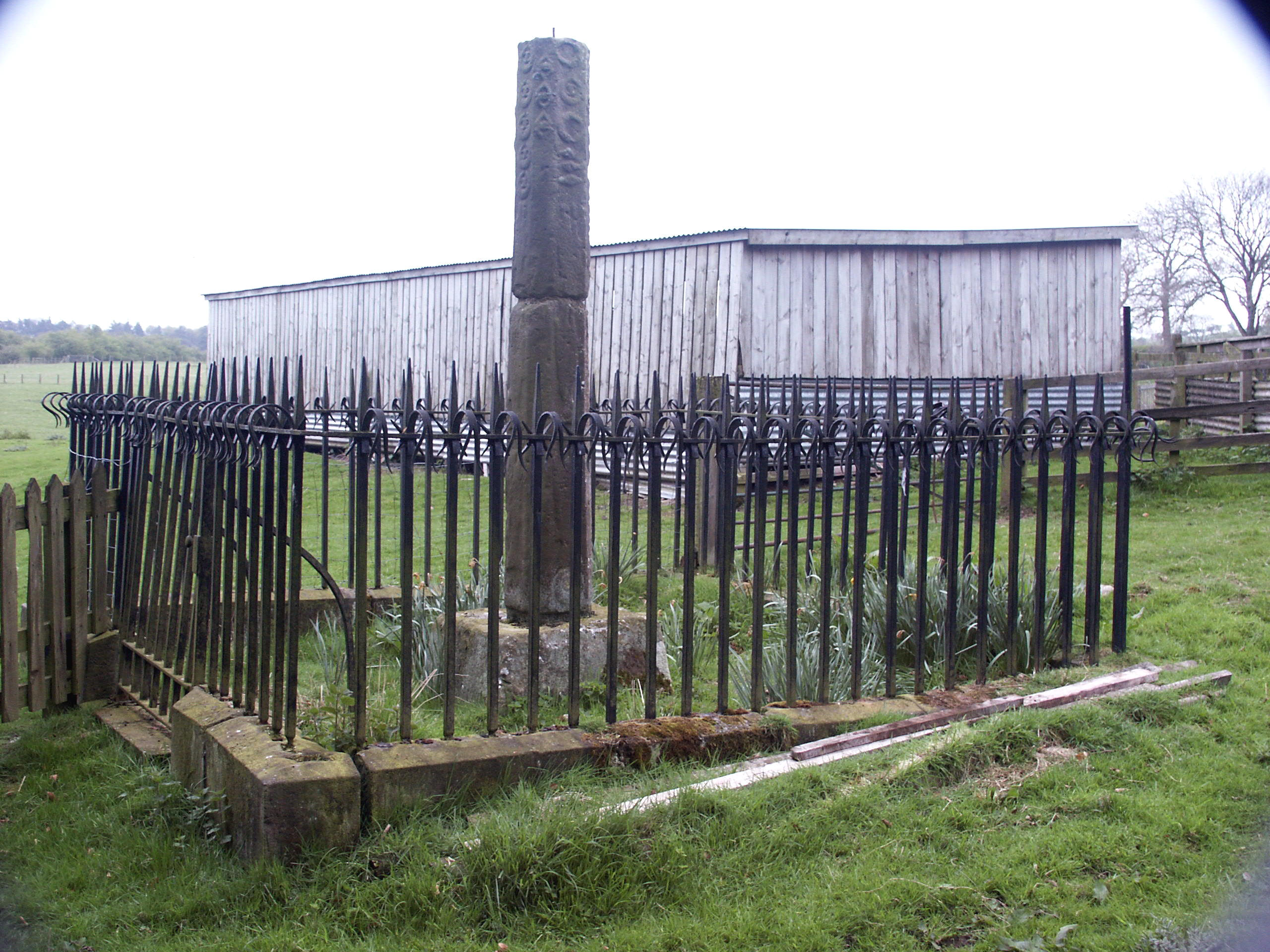
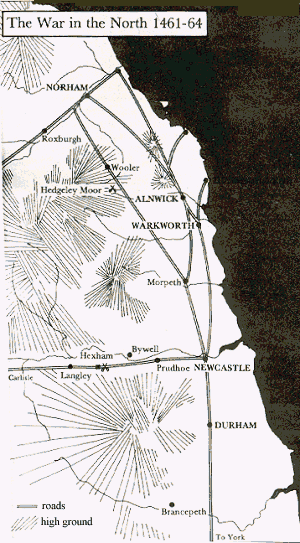
|
|
Major Participants of Battle of Hegeley Moore
|
| House
of York |
House
of Lancaster |
| Thomas
Borough (Brugh) of Gainsborough, Lincolnshire |
Henry
Beaufort, Duke of Somerset |
| John
Middleton of Belsay, Northumberland |
Sir
Henry Bellingham |
| Henry
Neville of Heversham, Westmoreland |
Sir
Thomas Finderne |
| John
Neville of Montague, Durham |
Sir
Ralph Grey |
| |
Thomas
Hungerford of Rowden, Herefordshire |
| |
Robert
Lord Moleyns, Lord Hungerford |
| |
Humphrey
Neville of Brancepath, Durham |
| |
Sir
Ralph Percy, killed in battle |
| |
Thomas
Roos of Rockingham, Northamptonshire |
| |
Henry
Lord Roos |
| |
William
Stock of Warmington, Northamptonshire |
| |
William
Talboys of Kyme, Lincolnshire |
| |
Sir
Richard Tunstall of Thurland, Lancashire |
| |
Sir
Thomas Wentworth of Yorkshire |
| |
Sir
Philip Wentworth |
|
|
Battle
of Hexham
May
14, 1464
The
Lancastrian position in the north, where lay their only remaining strength,
was fast crumbling. The Scots had agreed to cease sheltering them, and
their Northumbrian strongholds could not expect to withstand for long the
heavy siege weapons that Edward was hurriedly assembling. They put an army
into the field, and Lord Montagu again set out from Newcastle to oppose
it. He found Somerset�s men drawn up in a meadow called the Linnels some
three miles southeast of Hexham on the banks of the Devil�s Water.It
was a hopeless position from which to fight any sort of battle; the field
was almost totally enclosed and too cramped to allow of free maneuver.
The Lancastrian soldiers realized this and many left as the Yorkists approached
without so much as discharging an arrow. It required no great feat of generalship
to demolish those that stayed to fight. Montagu practically surrounded
the meadow, and then made a frontal attack through the one opening at the
east end. Those that were not killed in this attack were pressed across
the river into West Dipton Wood and forced to surrender. Battle casualties
were not great, but the executions that followed, including that of Somerset,
were on a scale unparalleled even in these bloodthirsty times. Henry remained
north of the Tyne during the fight and escaped to the Lake District, where
he was among predominantly loyal subjects. |

|
Major Participants of First Battle of Hexham
14 May 1464
|
| House
of York |
House
of Lancaster |
| Ralph
Lord Greystoke |
Sir
Henry Beaufort, Duke of Somerset, executed |
| Henry
Neville of Heversham, Westmoreland |
Sir
Henry Bellingham |
| John
Neville, Earl of Northumberland |
Sir
Thomas Finderne, executed |
| John
Scrope of Bolton, Yorkshire Lord Willoughby |
Sir
Edmund Fish, executed |
| Richard
Tempest of Bracewell, Yorkshire |
Sir
Ralph Grey, escaped |
| |
Henry
VI, King of England |
| |
Robert
Hungerford of Heytesbury, Wiltshire executed |
| |
Robert
Lord Moleyns, Lord Hungerford, executed |
| |
Sir
Humphrey Neville, escaped |
| |
Thomas
Reresby of Thrybergh, Yorkshire executed |
| |
Henry
Lord Roos, executed |
| |
John
Tempest of Bracewell, Yorkshire |
| |
Sir
William Tailboys, executed |
| |
Thomas
Wentworth of Yorkshire, executed |
| |
Philip
Wentworth of Nettlestead, Suffolk, executed |
|
|
Battle
at Bamburgh Castle
June 1464
After Hexham, the Lancastrians
held only the castles of Bamburgh, Dunstanburgh and Alnwick. The
castles had already changed hands more than once. Warwick and Montague,
now the Earl of Northumberland, brought the massive siege pieces of Edward
IV, set out to smother the last embers of Lancastrian resistance.
On the 23rd, Alnwick yielded followed by Dunstanburgh
the next day but Bamburgh refused the summons. Bamburgh was held
by Sir Ralph Grey and he had been exempted from the general pardon. Soon
the debris from the ramparts was being blasted into the sea, and resistance
quickly collapsed.
The affair is of interest in being the
first time that a battering train was used effectively in England. The
King�s great guns, �London� and �Newcastle� (made of iron) and �Dijon�
(a brass cannon), were supported by bombardels, and it was with some ease
that they breached the walls, allowing Warwick to lead an assault that
completed the work. Grey was seriously wounded, but this did not save him
from being dragged before the High Constable, John Tiptoft Earl of Worcester,
who made good on his reputation for recognizing no law but the axe. |
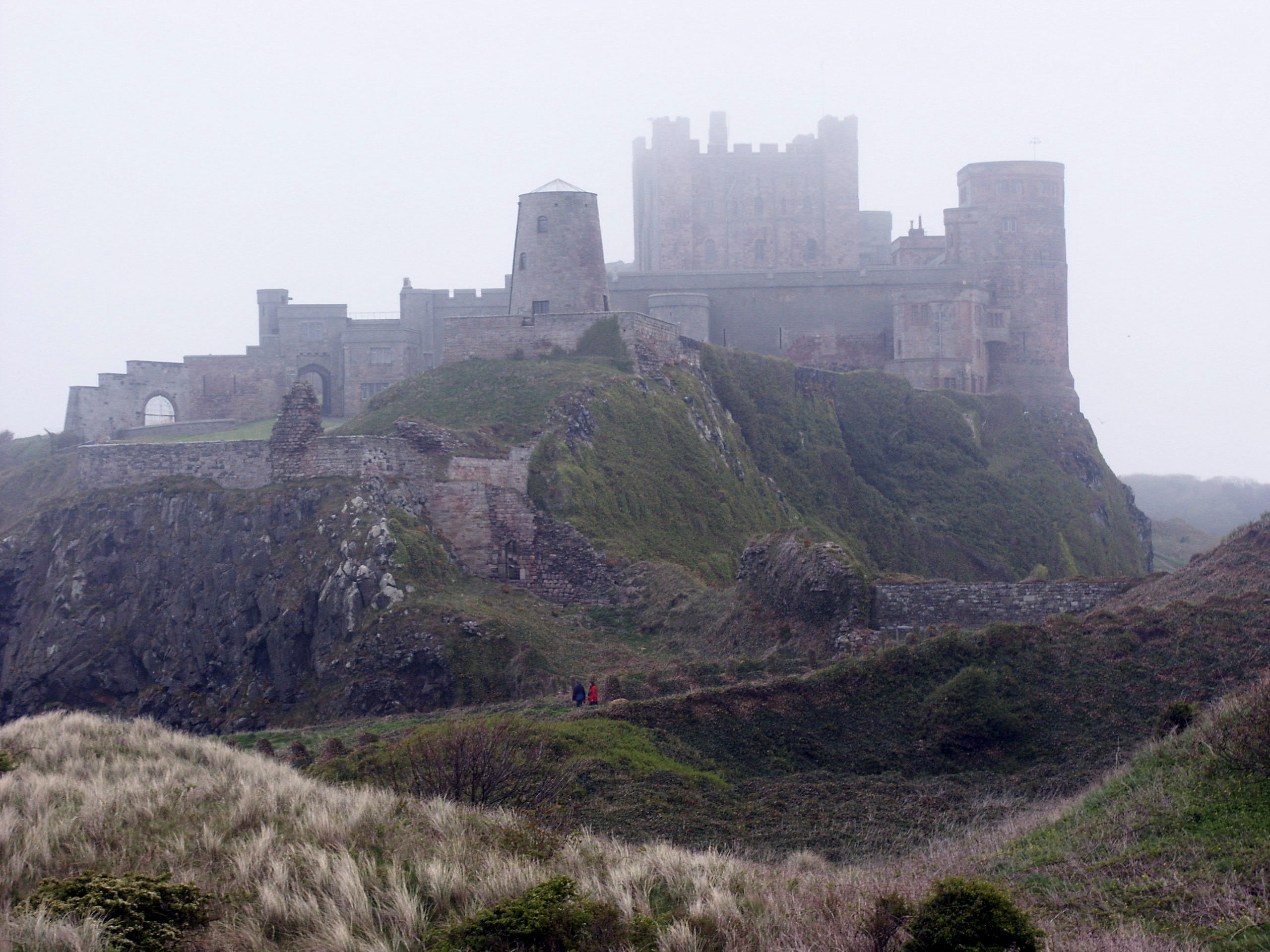 |
|
Major Participants of Battle of Bamburg Castle
|
| House
of York |
House
of Lancaster |
| John
Neville, Earl of Northumberland |
Richard
Neville, Earl of Warwick |
| Sir
Ralph Grey, executed |
Humphrey
Neville of Brancepath |
|
|
Battle
of Edgecote
July 26, 1469
While
in Calais, the Earl of Warwick and the Duke of Clarence inspired a series
of rebellions in the north to draw Edward IV northwards. In July the considerable
forces of 'Robin of Redesdale', Sir John Conyers who was one of Warwick's
retainers, forced Edward to move north to Nottingham. Here he waited for
William Herbert, Earl of Pembroke and Humphrey Stafford, Earl of Devon
to bring their retainers from Wales and the West Country.
Meanwhile,
Warwick and Clarence landed in Kent and marched on London with a large
army. From here Warwick sent Sir John Clapham north to rendezvous with
Sir John Conyers' rebels. All four armies now converged on the area around
Banbury.
On
25th July Pembroke with about 10,000 Welsh infantry and cavalry and Devon
with about 6,000 men, mostly archers, arrived at Banbury. They argued over
billets (or the favours of a landlord's wife) and Devon withdrew with his
men south to Deddington Castle, thus dividing their army at a crucial point.
On that same day the Welsh skirmished with the vanguard of Conyers' army,
which was coming from the direction of Daventry. This army may have been
as large as 20,000 men, but 10,000 to 12,000 are a more practical figure.
Clapham was at Northampton with around 6,000 men. |
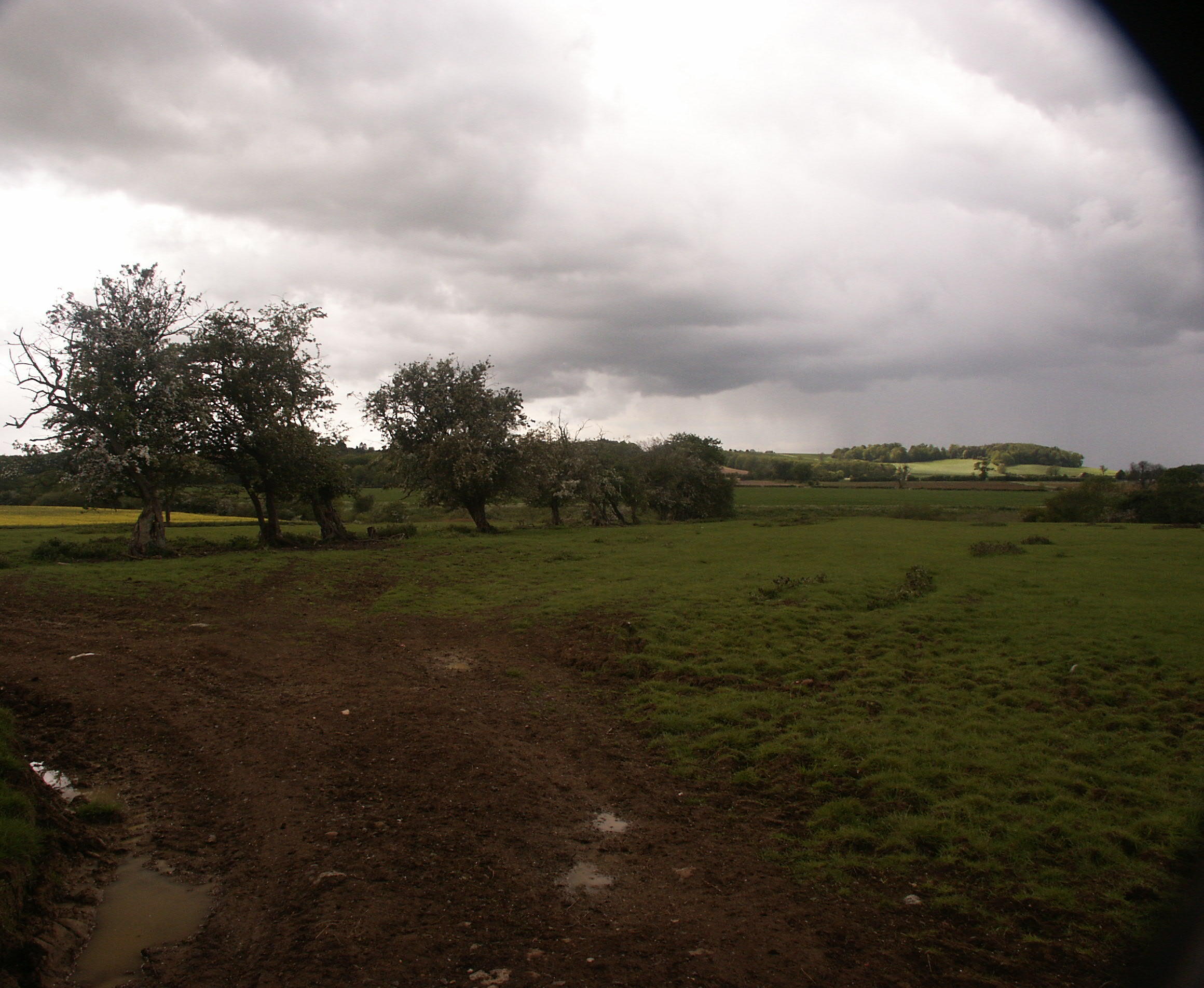
The following morning
Pembroke moved east out of Banbury and arrayed his army on high ground
on Danes Moor between Wardington and Culworth and waited for Devon to bring
up the main body of archers. To the south, Conyers arrayed his men near
Thorpe Manderville and advanced towards the Welsh showering them with arrows.
Pembroke, without Devon's archers, was forced to abandon his position and
charged downhill into Conyers rebels. A fierce melee ensued lasting two
or three hours. Just as the Welsh were getting the upper hand, Clapham
and his men appeared on the left flank of Pembroke's army and, crying "a
Warwick, a Warwick", they poured onto the battlefield.
The Welsh thinking Warwick's
army was attacking them as well put up fierce resistance but were eventually
driven from the field. About 5,000 Welsh lay dead on the battlefield and
all their leaders were captured and executed, including the Earl of Pembroke
and his brother Sir Richard Herbert. The Earl of Devon never reached the
battlefield and on learning of the defeat of the Welsh he fled with his
army, but was captured and executed at Bridgewater, Somerset a few weeks
later. One report by the Burgundian Jean de Waurin says that Devon withdrew
during the fighting.
|
|
Major Participants of Battle of Edgecote
|
| House
of York |
House
of Lancaster |
| John
Eynton |
William
Burgh |
| Sir
Richard Herbert, executed |
Sir
Geoffrey Cate |
| Sir
William Herbert, Earl of Pembroke, executed |
John
Chapman
|
| Sir
Henry Neville, killed in battle |
Sir
William Conyers |
| Thomas
ap Roger, killed in battle |
Sir
Henry Fitzhugh, killed in battle |
| Sir
Humphrey Stafford, Earl of Devon |
Sir
Henry Neville, killed in battle |
| |
Richard
Neville, Earl of Warwick |
| |
Sir
William Parr |













